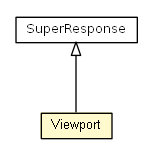cz.cuni.amis.pogamut.usar2004.agent.module.response
Class Viewport
java.lang.Object
 cz.cuni.amis.pogamut.usar2004.agent.module.response.SuperResponse
cz.cuni.amis.pogamut.usar2004.agent.module.response.SuperResponse
 cz.cuni.amis.pogamut.usar2004.agent.module.response.Viewport
cz.cuni.amis.pogamut.usar2004.agent.module.response.Viewport
public class Viewport
- extends SuperResponse
response message recieved after SET {Type Viewports} command
- Author:
- vejmanm
|
Method Summary |
String |
getConfig()
Describes the current viewport configuration. |
String |
getStatusFour()
Status of the viewport configuration after the SET command has been
issued. |
String |
getStatusOne()
Status of the viewport configuration after the SET command has been
issued. |
String |
getStatusThree()
Status of the viewport configuration after the SET command has been
issued. |
String |
getStatusTwo()
Status of the viewport configuration after the SET command has been
issued. |
String |
getViewportFour()
Each value is the name of the camera currently attached to viewportN,
where N is 1..4. |
String |
getViewportOne()
Each value is the name of the camera currently attached to viewportN,
where N is 1..4. |
String |
getViewportThree()
Each value is the name of the camera currently attached to viewportN,
where N is 1..4. |
String |
getViewportTwo()
Each value is the name of the camera currently attached to viewportN,
where N is 1..4. |
| Methods inherited from class java.lang.Object |
clone, equals, finalize, getClass, hashCode, notify, notifyAll, toString, wait, wait, wait |
type
public static final ResponseType type
Viewport
public Viewport()
- Ctor. Response type describes particular subject about which we want to
know about. It is used to distinguish incoming message from the server.
getConfig
public String getConfig()
- Describes the current viewport configuration. This parameter will be
either “SingleView” or “QuadView”
- Returns:
- Returns configuration of current viewport.
getStatusOne
public String getStatusOne()
- Status of the viewport configuration after the SET command has been
issued. The status will be “OK” when the viewport configuration was
successfully changed. Otherwise, the status will be “Failed”.
List of statuses is also used when setting cameras. Each value is then
the status for the camera’s field of view after the SET command has been
issued. The status will be “OK” when the camera’s field of view was
successfully changed. Otherwise, the status will be “Failed”.
When responsing to SET command for sensor or effecter, single value
describing the status of the transaction will be present in the list.
- Returns:
- Returns first status.
getStatusTwo
public String getStatusTwo()
- Status of the viewport configuration after the SET command has been
issued. The status will be “OK” when the viewport configuration was
successfully changed. Otherwise, the status will be “Failed”.
List of statuses is also used when setting cameras. Each value is then
the status for the camera’s field of view after the SET command has been
issued. The status will be “OK” when the camera’s field of view was
successfully changed. Otherwise, the status will be “Failed”.
When responsing to SET command for sensor or effecter, single value
describing the status of the transaction will be present in the list.
- Returns:
- Returns second status.
getStatusThree
public String getStatusThree()
- Status of the viewport configuration after the SET command has been
issued. The status will be “OK” when the viewport configuration was
successfully changed. Otherwise, the status will be “Failed”.
List of statuses is also used when setting cameras. Each value is then
the status for the camera’s field of view after the SET command has been
issued. The status will be “OK” when the camera’s field of view was
successfully changed. Otherwise, the status will be “Failed”.
When responsing to SET command for sensor or effecter, single value
describing the status of the transaction will be present in the list.
- Returns:
- Returns third status.
getStatusFour
public String getStatusFour()
- Status of the viewport configuration after the SET command has been
issued. The status will be “OK” when the viewport configuration was
successfully changed. Otherwise, the status will be “Failed”.
List of statuses is also used when setting cameras. Each value is then
the status for the camera’s field of view after the SET command has been
issued. The status will be “OK” when the camera’s field of view was
successfully changed. Otherwise, the status will be “Failed”.
When responsing to SET command for sensor or effecter, single value
describing the status of the transaction will be present in the list.
- Returns:
- Returns fourth status.
getViewportOne
public String getViewportOne()
- Each value is the name of the camera currently attached to viewportN,
where N is 1..4. If viewportN has been disabled, this parameter will be
“Disabled”. If viewportN has been attached to a non- existent camera,
this parameter will be “None”.
- Returns:
- Returns first viewport.
getViewportTwo
public String getViewportTwo()
- Each value is the name of the camera currently attached to viewportN,
where N is 1..4. If viewportN has been disabled, this parameter will be
“Disabled”. If viewportN has been attached to a non- existent camera,
this parameter will be “None”.
- Returns:
- Returns second viewport.
getViewportThree
public String getViewportThree()
- Each value is the name of the camera currently attached to viewportN,
where N is 1..4. If viewportN has been disabled, this parameter will be
“Disabled”. If viewportN has been attached to a non- existent camera,
this parameter will be “None”.
- Returns:
- Returns third viewport.
getViewportFour
public String getViewportFour()
- Each value is the name of the camera currently attached to viewportN,
where N is 1..4. If viewportN has been disabled, this parameter will be
“Disabled”. If viewportN has been attached to a non- existent camera,
this parameter will be “None”.
- Returns:
- Returns fourth viewport.
Copyright © 2015 AMIS research group, Faculty of Mathematics and Physics, Charles University in Prague, Czech Republic. All Rights Reserved.


cz.cuni.amis.pogamut.usar2004.agent.module.response.SuperResponse
cz.cuni.amis.pogamut.usar2004.agent.module.response.Viewport